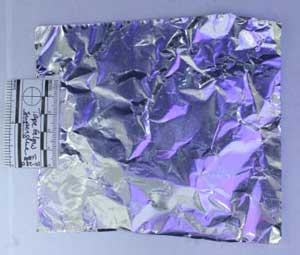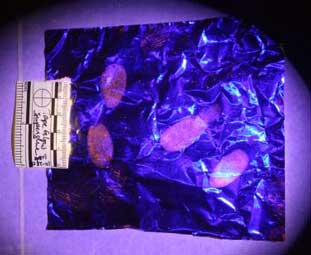We're Dyeing To ID Your Prints!
Crime Laboratory Division
Missouri State Highway Patrol
See also the instructional videos on "Latent Fingerprints"
New and improved techniques are being implemented throughout the laboratory, and the Latent Prints section is keeping pace. Several recent advancements in the fingerprint area have resulted in even more valuable identification tools for officers to use. To assist your agency in obtaining the best possible fingerprint information for identification, the criminalists in the MSHP lab's latent print sections would like to bring your attention to several changes and updates.
Caught You Whole-Handed!
For years, the Prints section has processed casework which resulted in palm prints. Agencies have received numerous reports advising that palmprints were developed, but currently could not be searched in the Automated Fingerprint Identification System (AFIS) fingerprint database. The only way for an identification to be made was to have an actual palmprint from the victim(s), suspect(s), or elimination(s). After an expansion of the database capabilities, AFIS can now search palmprints through the database. Even though palmprints are now eligible for AFIS entry, it is still a good practice to submit palmprint impressions for all of the individual(s) associated with a case.
Give me Five!
But not your five! Please wear gloves when processing latent print evidence, with frequent glove change. Prolonged glove use may cause sweaty hands, which can result in leaving YOUR latent print through a latex glove. Too often, the lab compares prints developed from a crime scene only to identify the officer who made the lifts or handled the item, which is time consuming for the lab and delays identification of the true individual(s) under investigation. We do not enjoy identifying YOUR print any more than you enjoy us calling you to tell you we have an identification in the case—and it is YOU!
How About Those Digits!
Latent print examiners in our lab now have the ability to print tenprint cards from the MSHP Criminal Records and Identification Division (CRID) instead of requesting them. In order to make this process efficient, agencies should provide the following information on the SHP-411 Lab Analysis Request form: Name of Individual, Date of Birth, Social Security Number, SID Number, and/or FBI Number. Analysts, however, still prefer to have known tenprint and/or palmprint exemplars submitted from any individual(s) associated with a case, rather than just assuming they are in the database.
Who Says We Can't Do That?
The Print section has recently validated and brought on-line dye staining techniques that allow detection of friction ridge prints that may not be visible by any other means. Certain properties of perspiration, body oils, and/or foreign substances contained in latent print residue fluoresce when a fumed latent is treated with a dye stain and exposed to a laser or alternative light source. Latent Print examiners can visualize and photograph latent prints developed through using these dye staining procedures, and then make comparisons to known prints.
 |
 |
Here We Go Again!
When resubmitting evidence to the lab, be sure to let the lab evidence technicians know that you are indeed resubmitting evidence in a case. They will reference the original lab number so that a new case number is not assigned. Abiding by this request will streamline the evidence processing and paperwork tracking. Remember this hint if you choose to resubmit your palmprints for further evaluation.
Size Makes A Difference!
All latent print lift cards and/or tenprint cards submitted to the lab or AFIS should be packaged in a 9.5” X 12” manila or white envelope. A suitable envelope is available free upon request: either use the SHP-415B order number for MSHP employees, or simply ask the lab evidence technicians at the lab counter. Placing your cards in an envelope of this size ensures safer storage, better evidence handling, and easier processing and retrieval for AFIS. Another reason that undersized envelopes are discouraged is that our lab barcodes are 1.5” X 4”, and they could cover valuable information on the container or get covered by evidence tape with the final seal.
Four Labs For Your Convenience!
The MSHP Lab System has four labs offering fingerprint services: General HQ in Jefferson City at 573-526-6134; Troop D Satellite in Springfield at 417-868-9400; Troop E Satellite in Cape Girardeau at 573-290-5130; and Jasper County Satellite in Carthage (available Fall, 2009).
The Prints section can do more for your fingerprint case than ever before. However, the key to quality latent print results begins with your agency. Your attention to detail, such as wearing gloves, proper evidence collection and packaging, quality tenprint cards (including palm prints), etc. greatly assists the criminalists with developing and comparing latent prints. If you have questions, please contact the latent print section.

